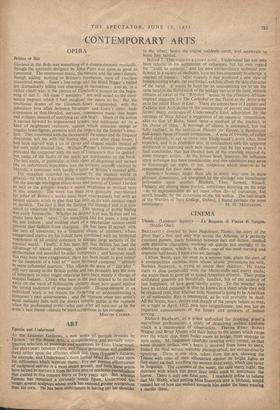ART
Epstein and Underwood
AT the Leicester Galleries, a new series of portrait bronzes by Epstein ; at the Beaux Arts, a comprehensive and partially retro- spective selection of paintings and sculptures by Leon Underwood. Ten short years between them, and future generations will doubtless dwell rather upon the affinities which link them (Epstein's Lazarus, for example, and Underwood's more formal Mind Slave) than upon the differences which separate them. For our present efflorescence of sculptural activity is a most recent growth, and both these artists have helped to nurture it from the little plot of academic parochialism that existed in this country thirty or forty years ago. But whereas Epstein has remained a curiously lonely figure, Underwood has taught several sculptors whose work has received greater recognition than his own. He has been unfortunate in having put his shoulder
to the wheel, heard the. engine suddenly catch, and accelerate to leave him behind.
Behind ? That suggests a closed mind. Underwood has not only been eclectic in his acceptance of influences, but his own regard for "truth to material" and his own extraordinary technical pro- ficiency in a variety of mediums, have led him constantly to attempt a renewal of manner. Most recently it has produced a new view of bronze casting which, cut and folded, exhibits afresh the skin character of the metal. It would be had for an unsuspecting eye to sec the same hand in the florid mask of the midday-sun as in the hard, smooth ribbons of metal of the "Rhythm" series; in the primitive African- inspired maquette for The Cathedral or the Totem to the Artist-tribe as in the inlaid Music in Line. There are echoes here of Lipchitz and Zadkine and Archipenko in the counterplay of convex and concave forms; many evidences of Underwood's frank admiration for the carvings of West Africa; a suggestion of an eccentric romanticism, akin to that of Blake, based upon a mistrust of the intellect, in his choice of titles. A marriage of idioms is attempted, but not fully realised, in the ambitious Phoenix for Europe, a flamboyant half-length figure of recent completion. A note of frivolity, of rather florid rhetoric, is apt to creep into Underwood's work when least expected, and it is doubtless this, in conjunction with his apparent disinterest in pursuing each new manner that he has essayed to a final conclusion, that has cheated him of the standing enjoyed by some younger artists. At the lowest level, however, his influence upon technique has been considerable, and this exhibition may serve to disentangle say eight, or ten, sculptures which deserve to be remembered for their own sakes.
Epstein's bronzes, larger than life in every way' save in mere physical dimensions, are energized by the clashsef one tumultuous personality upon another. Blackett, Eliot, Samuel, Russell, Flaherty are among those present, sometimes teetering on the edge —as so expressionistic an art must often do—of caricature, but saved, usually, by the dynamism of the life within. The half-length of the Warden of New College, Oxford, I found perhaps the most


















































 Previous page
Previous page